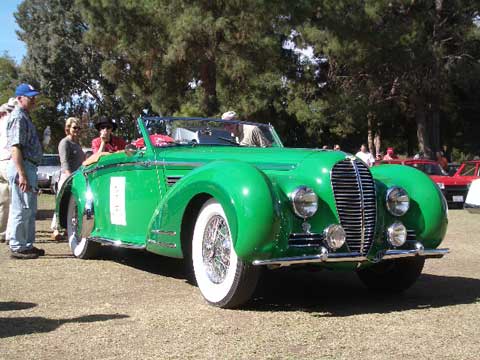
Photo by Brandy Elitch.
When Terry Cook was the Editor of HOT ROD in the early 1970s, he had always been more passionate about how cars look than how fast they can accelerate, brake or go around corners. To Cook, styling was everything. He became interested in the French and German coachbuilders who, during the 1930s and 1940s pushed the envelope with bold, fresh, risky styling.
“It may be subjective, but I feel the best looking cars in history came from Paris-based coachbuilders in the golden era of 1936 to 1939. This was back when fenders were still separate design elements before they got absorbed into slab-sided bodies of the post war period.â€
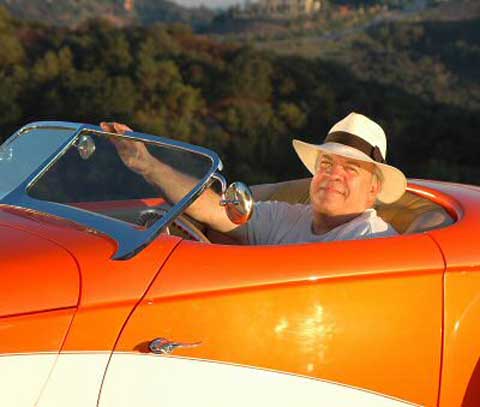 Terry Cook, courtesy Terry Cook.
Terry Cook, courtesy Terry Cook.
Today Cook is “living his dream”. The creation of DELAHAYE USA in April of 2007 has fulfilled his fantasy of building aluminum bodied cars, including a Shah of Persia Type 57 SC Bugatti and a Figoni & Falaschi Type 165 Delahaye. Below, he offers VeloceToday a brief perspective of his favorite French stylists.
French Dressing
By Terry Cook
Johannes Beeskow, Jacques Saoutchik, Giuseppe Figoni, Georges Paulin and Jean Bugatti were among the most dramatic of the pre-war designers.
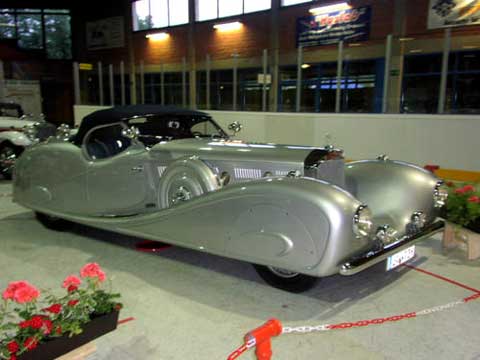 Beeskow’s Mercedes was the hit of the 1933 Berlin Motor Show. Courtesy www.coachbuild.com
Beeskow’s Mercedes was the hit of the 1933 Berlin Motor Show. Courtesy www.coachbuild.com
Picking up on this dramatic trend were coachbuilders such as Erdmann and Rossi, who were focusing on designing cars with low aerodynamic drag for increased fuel economy. Erdmann & Rossi’s chief designer Beeskow shocked the automotive world with a fastback Mercedes at the 1933 Berlin Auto Show, and followed up at the 1935 Berlin show with an enclosed fender 540 K Sports Cabriolet, predecessor to the legendary open fendered 540K. It is hard not to believe that these beautiful shapes had an influence on Figoni. He also collaborated on the teardrop fender shape of the type 135 Delahaye with French airplane/automobile/motorcycle fine artist/illustrator Geo Ham (Georges Hammel).
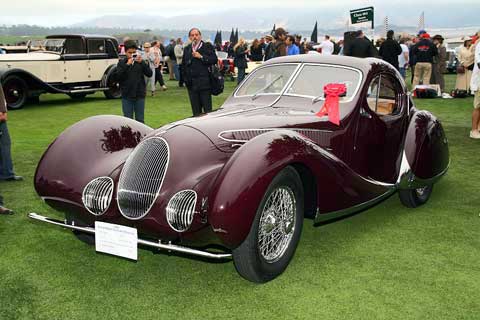 The classic teardrop Talbot Lago Figoni et Falaschi coupe, still winning concours. Photo by Hugues Vanhoolandt.
The classic teardrop Talbot Lago Figoni et Falaschi coupe, still winning concours. Photo by Hugues Vanhoolandt.
Paris based Italians Giuseppe Figoni & Ovidio Falaschi are the coachbuilders best know for slippery shapes, producing 700 custom bodied cars before the war and another 450 in the postwar period before closing their doors in 1955. Clearly some of these were the most beautiful cars ever made including their luscious Delahayes, Darracqs and teardrop Talbot Lago Coupes. Like Saoutchik however, not all of Figoni’s designs were breathtaking. In a constant effort to outdo themselves and come up with something new and different, both designers created “Narwhal” nosed Delahayes that sadly looked like proboscis monkeys and a number of others creations that missed the mark.
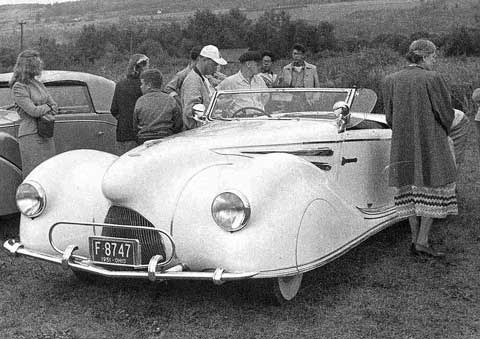
A “narwhal’ surfaces at Watkins Glen in 1950. Note the bulbous proboscis. Photo by Frank Shaffer.
Russian cabinet maker Iakov Saoutchik, better known as Jacques after relocating to Paris in 1905, produced coachbuilt cars for the kings of Cambodia, Siam, Egypt, Norway and the Emperor of Ethiopia. He turned his business over to his son in 1952, and his business closed in 1955. During that half decade, however, he produced a series of what may be the most daring, outrageous, flamboyant automobiles in history. Like Figoni and more so than other coachbuilders of that period, he often embellished his creations with giant, sweeping chrome spears.
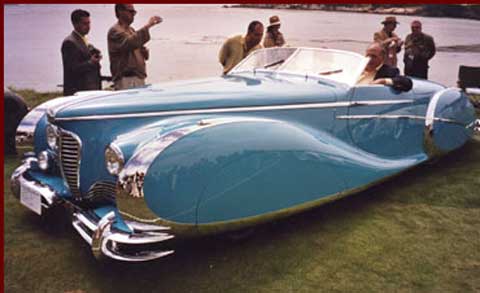
A Saoutchik bodied Delahaye. The fender chrome is a giveaway styling motif.
Lesser known French dental assistant and part time automotive stylist Georges Paulin created a number of totally delicious cars for coachbuilder Marcel Pourtout. Sadly Pauline was executed by the Nazis for his other part time job, being a member of the French underground.
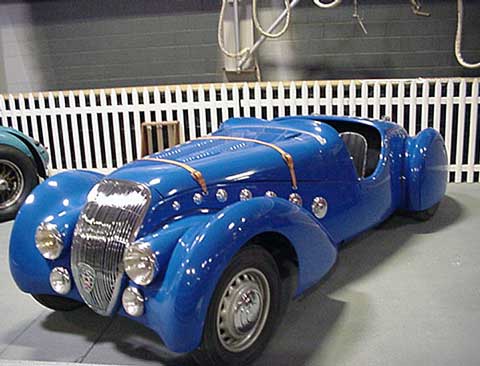
A rare Peugeot Darl’mat at the Simeone Foundation. Photo by Pete Vack
Before his death however, he designed some of the world’s most beautiful automobiles including the Embricos Bentley, the Peugeot Darl’mat roadster, the innovative retractable roof Peugot 601 Eclipse, four Talbot Lago coupes and the stunning Delage DS 120.
While people don’t think of him as a stylist, Ettore’s son Jean Bugatti was influential in the design of a large number of cars that stand the test of time, such as the Atlantic.
I can’t afford to own a real Bugatti or Delahaye, but that doesn’t mean I can’t try to build cars that look like them. Check www.decorides.com for my composite bodies cars and www.delahayeusa.com for my alloy bodied clones.
Below is a list of what cars I think qualify for the ten best Pre War designs. Your thoughts and comments are of course welcome.
THE 10 BEST LOOKING PRE-WAR CARS
1. Early Al Leamy designed 1929-1934 Auburn Boattail Speedster or 1935-1936 Gordon Buehrig Auburn Boattail.
2. Talbot Lago “Teardrop” Coupes by Figoni & Falaschi (something like 11 cars built) or Porteau Talbo Lago coupes (4 built).
3. Type 135 Delahayes and similar Darracq by Figoni & Falaschi (almost identical)
4. Type 165 Delahaye Cabriolet by Figoni & Falaschi (two built?)
5. 1938 Alfa Romeo BC 2900B Touring Berlinetta (33 built)
6. 1935-1937 Type 57SC Bugatti Atlantic (3 built)
7. 1936 500K and 540K Mercedes by Erdmann and Rossi (I don’t know how many 500K’s there were but 319 of the latter were built, including perhaps 3 fastback coupes)
8. 1937 Delage D8-120 Aerosport with Pourtout-Georges Pauline body (Note: There are lot of beautiful Delages, so it’s hard to pick just one. I’m not sure now many of this model were built).
9. 1937-1938 Peugeot 402 Darl’mat Roadster with Pourtout-George Paulin body
10. What did I leave out? Duesenberg?
NOTE: One of a kind cars like the Saoutchik 1938 Hispano-Suiza H6C Dubonnet Xenia Coupe, the Van Vooren 1939 Shah of Persia Type 57 Bugatti and the 1936 Maharaja Duesenberg with Gurney Nutting LTD of Croydon, England coachwork, designed by a junior designer at A. F. McNiel’s by the name of John Blatchley, are not eligible for our list as they are one off’s.
Pete,
Not disappointed yet! This is all good stuff. It would be interesting to know a little more about Delahaye USA and how the Terry Cook got yo Hot Rod in the first place.
More about Terry Cook can be found on his website, http://www.decorides.com.
Pete
Pete, Brandy, and Terry,
Thanks for the wonderful history/memories. Interesting to note that the British press at the time hated these designs, often referring to them as vulgar. And, I would have to agree as far as the narwhal look. Though sadly, I must admit, it was very futuristic as all current F1 cars have this proboscis!
Terry, I think we may all agree on your “Best Looking PreWar” list.
John Sexton
To John Sexton
Interesting that head of Jguar refereed to Figoni & Falaschi as “Phoney and Flashey”, yet in about 1950 (or so) first XK 120 Jags bore a strong resemblance to Figoini’s fadeaway fender Type 165 Delahaye.
Cheers